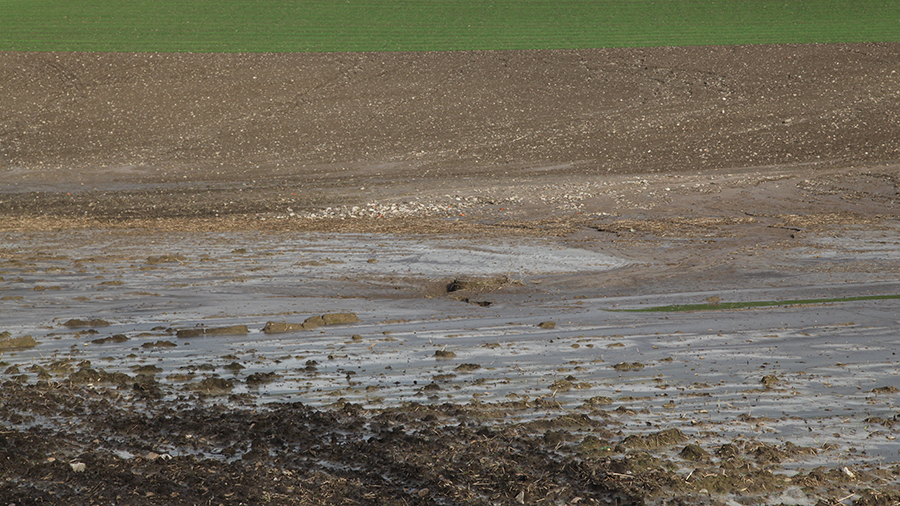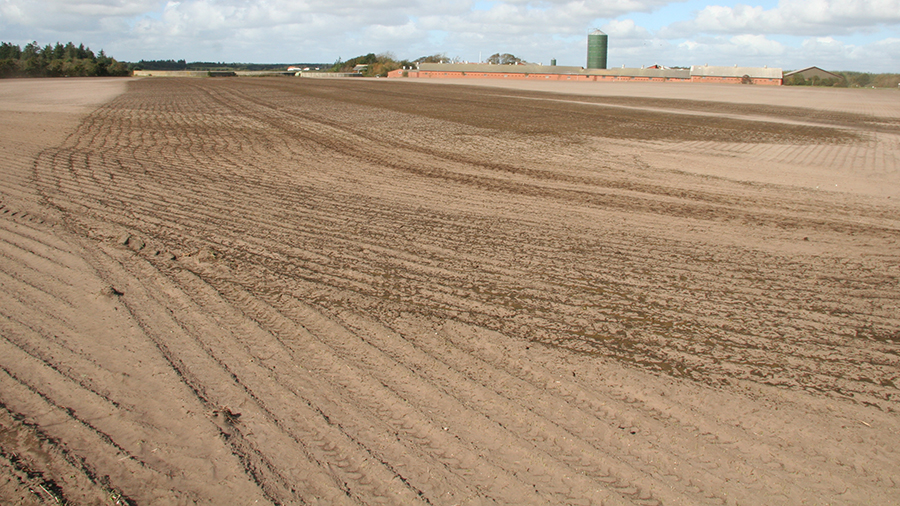With a cover of vegetation, the soil gains a protective layer and is not directly exposed to the effects of rain and wind. However, cultivated and bare soil can be severely affected by water erosion and by wind erosion.

Water erosion
On sloping land, water erosion can be severe when rain beats down on bare soil without a plant cover or plant residues on the surface. The clay particles carried off by rain are accompanied by particle-bound phosphorus, which collects at the lowest point in the field or is lost to drains.

Wind erosion
On dry, bare soil, wind erosion can cause damage when bouncing sand grains whip the emerging crop. As this photo shows, slurry can reduce wind erosion by binding the soil and preventing soil movement.
Water carries away P
Heavy rain and intensive snowmelt can transport soil away from arable land. This water carries away soil particles, plant nutrients and organic material to streams, lakes and seas. Sloping fields are the worst affected. The steeper the slope, the greater the erosion since the speed of water runoff increases.
A doubling in runoff speed down a slope gives water four times as great erosive force on the soil. Losses of phosphorus (P) can increase sharply with water erosion, since much of the phosphorus in soil is bound to the surface of clay particles.
Bouncing in the wind
Wind can also shift particles around the size of a grain of sand or less when the soil is bare and dry. Material <1 mm bounces along over the surface, while material <0.1mm can be carried freely in the wind. Loess soils are formed as wind-borne deposits.
Wind erosion can be decreased by planting shelterbelts, adding manure to the soil surface and growing protective crops. The wide open prairie areas in e.g. the USA and Canada for example are severely affected by wind erosion.
Minimal tillage helps
In such prairie areas or in areas of sloping arable land, various forms of minimal tillage are recommended and applied as a countermeasure to both wind and water erosion. A shallower tillage depth means that harvest residues are accumulated in the uppermost layer of the soil. This increases the amount of organic material in the upper soil layer, which in turn improves aggregate stability and renders the soil more resistant to the impact of raindrops and the drag of wind.
When ploughing a sloping field, contour ploughing is a useful method to decrease the risk of erosion. It takes advantage of the topography of the field to ensure that water infiltrates on the spot instead of running off along furrow trenches.
Plant cover protects
Harvest residues that are left on the soil surface are another contributing factor to why minimal tillage protects against erosion. In general, both plant and residues on the surface effectively slow the rate of movement of water and wind over the soil surface. In purely physical terms, a growing plant cover or plant residues also actively protect against the impact on raindrops on the soil surface as one example.
Among our usual crops, a permanent grass ley provides the best protection, while cereal offers moderate protection. Row crops such as sugar beet or maize leave part of the soil bare and thus provide weaker protection. The worst option from an erosion perspective is a cultivated fallow with nothing growing and no crop residues left on the soil surface.
Dictionary:
Loess soil = porous, wind-deposited soil that often has particles in the size range around silt (see more in table "Particle size distribution" in chapter The building blocks of soil). Loess soils are found in Eastern Europe and Ukraine and can extend to a depth of over 100 metres
Contour ploughing = involves ploughing along the height contours of the land

